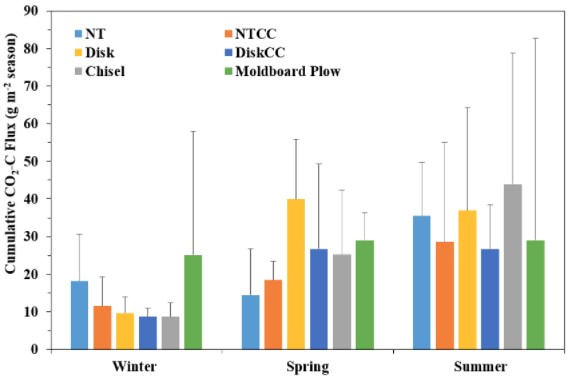By Ivori Schley
Figure 1. Moldboard plowing at an experimental site in eastern Nebraska.
Tillage is an important agricultural practice to manage crop residues, control weeds, and prepare the soil for planting, among others (Figure 1). However, the use of tillage can stimulate loss of soil organic carbon (C) to the atmosphere as carbon dioxide (CO2). Losses of CO2 may depend upon the degree of soil disturbance. The loss of soil carbon can reduce soil productivity, increase the need for fertilizer inputs, and reduce farm profits. Thus, it is important to understand how different types of tillage may affect soil CO2 fluxes in the long term.
How Do Soil CO2 Fluxes Occur?
Carbon dioxide is the most abundant soil gas and is the result of a natural process called soil respiration. Soil respiration occurs through microbial metabolic processes that decompose soil organic matter. Tillage systems affect soil CO2 fluxes by directly affecting soil properties. Tillage breaks down soil aggregates that keep soil organic matter inaccessible to microbes and incorporates crop residues, exposing the darker soil that readily absorbs rather than reflects solar radiation (Figure 2).
This means greater soil temperatures, reduced soil moisture, and potentially greater soil gas fluxes. In addition, a system under intensive tillage practices may result in increased CO2 fluxes due to increases in soil aeration and disruption of soil aggregates. The alternative method to tilling soil is to use reduced till or no-till systems. Reduced tillage methods usually consist of minimal soil disturbance and allow residue accumulation at the soil surface, which can lead to soil moisture retention and reduced fluctuations in soil temperature, potentially lowering CO2 fluxes. Depending on the environment, no-till ideally mitigates soil gas emissions from the soil, which in turn preserves soil quality.
Figure 2. Chisel plowing incorporating crop residues. Note the darker soil surface after plowing that leads to warmer soil temperature and greater evaporation.
Effects of Tillage System On CO2 Fluxes
Previous research has shown that tillage effects on CO2 fluxes may depend on tillage type and timing. Greater tillage intensity generally results in greater CO2 fluxes (Table 1), and effects of tillage are often confined to the days or seasons when tillage occurred. Tillage generally decreases soil bulk density and increases soil porosity by loosening the soil. Changes in these soil properties are not, however, permanent as they tend to return to pre-tillage state due to natural reconsolidation, wetting and drying cycles, and other factors.
Table 1. Two previous studies on soil gas fluxes in the Corn Belt.
| LOCATION | SOIL TEXTURE | DURATION OF STUDY (YEARS) | TILLAGE TYPES | CROP | KEY FINDINGS | REFERENCE |
|---|
| INDIANA | Silty clay loam | 30 | Moldboard, Chisel, No-till | Corn and Corn-Soybean | Tillage effects confined to immediately after tillage (Chisel>Moldboard>No-till) Tillage effects through growing season were minimal | Omonode et al., 2007 |
|---|
| OHIO | Silt loam | 43 | Moldboard, Chisel, No-till | Corn | Tillage did not affect CO2 fluxes in winter and spring, but summer and fall fluxes were: No-till<Moldboard<Chisel | Ussiri and Lal, 2009
|
|---|
Case Study in Nebraska
Few have studied long-term tillage impacts on soil gas fluxes in the western Corn Belt. From fall 2016 through summer 2017, soil CO2-C flux was monitored from a long-term tillage experiment (35 years) with six tillage treatments (chisel, plow, disk, disk with rye cover crop, no-till, and no-till with rye cover crop) on a silty clay loam at Rogers Memorial Farm near Lincoln. The cropping system was a corn-soybean rotation and soil CO2 fluxes were monitored beginning after the soybean phase. Soil samples for analysis of particulate organic matter (POM), which is easily decomposed organic matter, were collected seasonally. Soil gas fluxes were collected immediately following tillage, after one week, and then monthly.

Figure 3. The influence of tillage system on CO2-C flux by season in a long-term tillage experiment in eastern Nebraska. Bars denote standard deviation of the mean. NT = no-till, CC = cover crop
Figure 4. The influence of tillage system on spring particulate organic matter fractions in a long-term tillage experiment in Nebraska. Bars denote standard deviation of the mean. NT = no-till, CC = cover crop
Results showed that tillage system did not affect seasonal cumulative CO2-C flux (Figure 3). However, within the season when tillage occurred (fall for moldboard plow and chisel, spring for disk, chisel, and moldboard plow), fluxes tended to be greater with tillage than with no-till. Fluxes tended to be greater in summer compared to winter and spring, likely due to warmer soil temperatures. Particulate organic matter, the easily degraded portion of organic matter, may show significant impacts due to tillage. In winter, particulate organic matter concentrations were lowest with the plow compared to less intensive tillage treatments (Figure 4). In spring, particulate organic matter concentrations were lowest in chisel and moldboard plow treatments compared to disk or no-till treatments, potentially due to soil disturbance and oxidation of soil organic matter. The reduction in particulate organic matter concentration with moldboard plow or chisel plow can lead to reductions in soil organic matter concentration compared with no-till although CO2-C fluxes were generally not greater under plow or chisel treatments compared to no-till.
Previous studies suggest that soil moisture and soil temperature affect soil gas fluxes, depending on season and tillage. Results from the Nebraska case study showed that cumulative CO2-C fluxes calculated by season tended to be greater with greater tillage intensity, particularly during the season in which the tillage occurred. Further, the losses of easily decomposable organic matter with high-intensity tillage compared to no-till indicate that high-intensity tillage may be detrimental to soil biological activity and thus nutrient cycling.